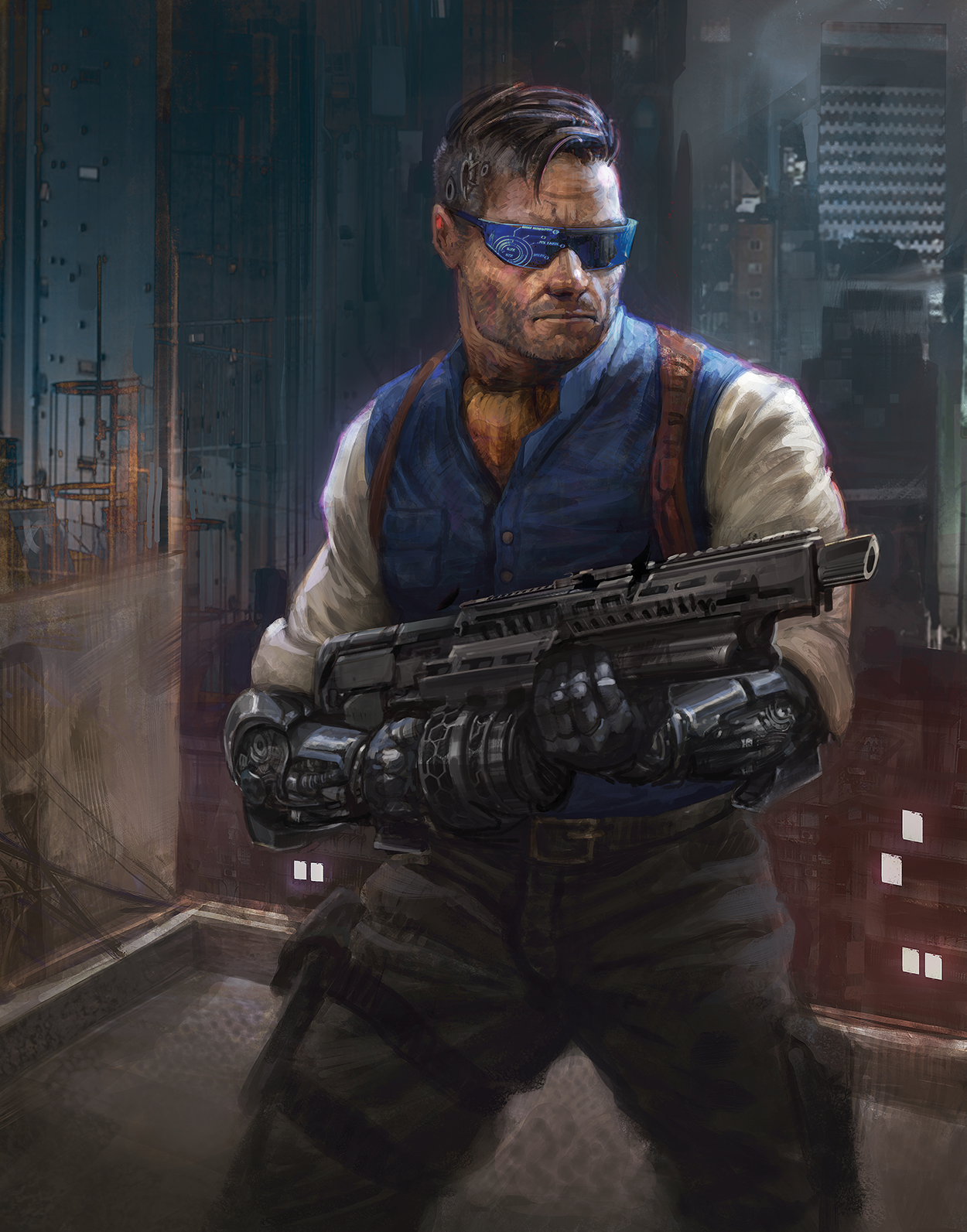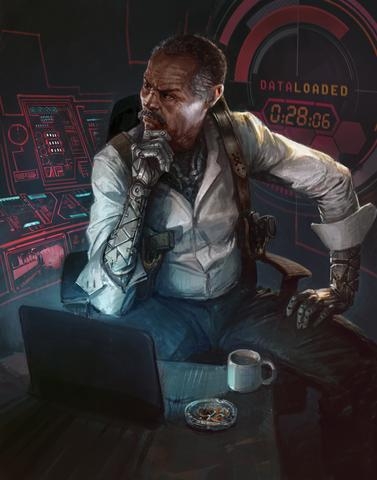On the blog today we have an interview with Joseph McGuire, author of the newly-released Reality's Edge: Cyberpunk Skirmish Rules.
For those who don’t know you, give us a quick introduction!
My name is Joseph McGuire, I’ve been a wargamer since 1997 starting with the Games Workshop stable of games and working my way into fields more varied and esoteric. My main claim to fame is being the author of This Is Not a Test, a set of post-apocalypse rules that I have been assured are pretty good. I write by night and during the day I am a humble family man and civil servant.

Artwork by Thomas Elliott
What game pulled you into the hobby, and what was it about it that grabbed you?
My first love was Warhammer 40K. In 1997 I was a 20-year old geek who walked into a gaming store that no longer exists. On the shelf was the Games Workshop 1997 miniatures catalogue, the one with the Interrogator Chaplain by Mark Gibbons on the cover. Seeing that beautiful piece of grimdark art brought me heart and soul into the hobby. As the kids say, it made me squee. From there I would deep dive into the lore of Warhammer 40K, start multiple armies, play hundreds of hours of games, and become a lifelong miniatures hobbyist.
What motivated you to create Reality’s Edge?
After This is Not a Test, I know I wanted to do another ruleset. In my college years, I was big into cyberpunk. I loved the lingo, the punk rebel aesthetic, and the whole style over substance aspect of the genre. Osprey asked me if I was interested in making a low-tech sci-fi game, sort of like Necromunda. I was totally on board and we both agreed a cyberpunk version of This Is Not a Test would be epic. I was motivated about bringing the experience of the classic Shadowrun/Cyberpunk 2020 to miniature wargaming and from there the game took on a life of its own.
Reality’s Edge isn’t your first game – you also designed the award-winning This Is Not a Test ruleset. How much did your work on TNT feed into the creation of this new game?
This Is Not a Test is about 170 pages and when I first starting working on Reality’s Edge, I thought I was just making a new version of This Is Not a Test with a different overlay. But that’s not what actually happened. While they share mechanics and a lot of special rules, the cyberpunk genre is both complex and multi-faceted. To truly bring that experience home, I started adding lots of options that do not exist in This Is Not a Test. Twenty pages of cybernetics, ten pages of rules for hacking, pages dedicated to illegal drugs, rules for moving crowds of bystanders, and the list goes on. Reality’s Edge moved beyond the writ of This Is Not a Test and really pushes the boundary between a full roleplaying game and a table top miniatures wargame. I wanted to give players a full and immersive cyberpunk experience and even I admit, I may have went a little overboard.

Artwork by Thomas Elliott
For players, the Cyberpunk theme for Reality’s Edge will be right at the core of their experience. When creating the game, to what extent did the theme dictate the way the rules evolved?
The theme really directed the creation of the game. Cyberpunk at its core is really about the corrupt and misappropriated use of technology, morally bankrupt and ultra-poweful capitalist corporations and nation-states, and small bands of outsiders who rebel against this reality in any way they can. But since Neuromancer was first published in 1984, the genre has come to mean different things to different people. So as an author, I had to define what cyberpunk meant to me personally and to the game experience. I wanted to deliver a bottom-feeder experience of mercenary operatives who are not world-class athletes or equipped with bleeding edge cybernetics. Sure, they have that chrome, but it’s expensive and costs them their humanity. I wanted a worldwide Internet that could be interacted with via an online avatar and I wanted the game to conceptually have a virtual reality component, even though the game is purely a physical tabletop experience with miniatures. I wanted drones, turrets, a crowed street full of bystanders that influenced the game as much as players. Slowly, all these ideas come to be in the rules and created what I think is a unique experience.
Players across the globe will be getting their Reality’s Edge crews together and preparing for their first game as we speak. Any tips for new players?
Don’t panic. Reality’s Edge is very intimidating and at first pass seems to have a high bar to entry. It’s 320 pages long with a ton of options. But most of the options are not going to be immediately useful. In the book, there is a Getting Started section on how to read the rulebook. When starting out read the world building parts, as short as they are, then get comfortable with the mechanics. Then move on to building your crew and go on from there. The rest of the book can be referenced as needed. But perhaps the most important thing is to find miniatures you like and work backwards from there. Showrunners lead your crew and they can all look like whatever you want. Our heroes are all unique personalities, so go with whatever crazy concept your heart desires. Never let the rules get in the way of fun.
If you could give one piece of advice to prospective game designers, what would it be?
To quote a game design class I attended, ideas are useless. Everyone has ideas. The go-getters may even have written them down. But until you start the first step to writing a game, they are useless. Writing a game is hard, but so is everything worthwhile. The first step is that you must believe that you can write a game. Read that back to yourself. I did not say write a good game. Once you escape the initial inertia of putting your ideas to paper and expounding on them, you have jumped the largest hurdle a writer has to face. After that it’s just a matter of putting one foot in front of another and starting to walk.
Reality's Edge: Cyberpunk Skirmish Rules is available now. Order your copy today!

Comments
You must be logged in to comment on this post. Click here to log in.
Submit your comment